Pre-print draft: arXiv:1012.6980
Journal: The Astrophysical Journal Volume 767 Number 1
Finding η Car Analogs in Nearby Galaxies Using Spitzer:
I. Candidate Selection
Rubab Khan, K. Z. Stanek, C. S. Kochanek
Abstract:
The
late-stage evolution of the most massive stars such as η Carinae is
controlled by the effects of mass loss, which may be dominated by
poorly understood eruptive mass ejections. Understanding this
population is challenging because no true analogs of η Car have been
clearly identified in the Milky Way or other galaxies. We utilize
Spitzer IRAC images of 7 nearby (=<4 Mpc) galaxies to search for
such analogs. We find 34 candidates with a flat or rising mid-IR
spectral energy distributions towards longer mid-infrared wavelengths
that emit 10^5 L_sun in the IRAC bands (3.6 to 8.0 micron) and are not
known to be background sources. Based on our estimates for the expected
number of background sources, we expect that follow-up observations
will show that most of these candidates are not dust enshrouded massive
stars, with an expectation of only 6+-6 surviving candidates. Since we
would detect true analogs of η Car for roughly 200 years post-eruption,
this implies that the rate of eruptions like η Car is less than the
ccSN rate. It is possible, however, that every M > 40 M_sun star
undergoes such eruptions given our initial results. In Paper II we will
characterize the candidates through further analysis and follow-up
observations, and there is no barrier to increasing the galaxy sample
by an order of magnitude.

Fig.
1.— The Spectral Energy Distributions (SED) of η Car now (blue solid
line, Humphreys & Davidson 1994), Object X (black solid line, Khan
et al. 2011), and M33VarA (black dashed line, Humphreys et al. 2006).
The black triangles mark luminosity at the IRAC band centers. Although
η Car and Object X have similar luminosities up to 3.6μm, the SED of η
Car is steeply rising in the IRAC bands (a≃2.6) while Object X is
almost flat (a≃0.2). Object X and M33VarA (Hubble & Sandage 1953;
Humphreys et al. 2006) are both dust obscured stars with comparable
bolometric luminosities (Khan et al. 2011), but in the IRAC bands,
Object X is much more luminous (~1.5x10^5 L_⊙) than M33VarA (~0.5x10^5
L_⊙).

Table
1 — We selected 7 galaxies spanning a range of mass, morphology,
distance, and star formation history. Since this is a pilot study, the
sample is deliberately eclectic rather than focused on a sample
maximizing the star formation rate per galaxy. Ultimately we would like
to examine all nearby galaxies rather than just a few. This table
summarizes the properties of the targeted galaxies. The absolute
magnitude M_B and Hα luminosity L(Hα) are from Kennicutt et al. (2008),
and L(Hα) is converted to star formation rate (SFR) following Equation
2 of Kennicutt (1998). The foreground Galactic extinctions are from
Schlafly & Finkbeiner (2011). The targeted galaxies have an
integrated SFR of ~2M_⊙/year. For the assumed Salpeter IMF of Kennicutt
(1998), we can convert this to the massive (M > 8M_⊙) star formation
rate of ~0.014/year. The observed ccSN rate over that 20 years is
~0.15/year (0.05 < R_SN < 0.35 / year, at 90% confidence). Since
the ccSN rate should agree with the massive-star formation rate, this
is a significant discrepancy for which we have no obvious explanation,
and such mismatches are also found in other contexts (e.g., Horiuchi et
al. 2011). The nearest of our targeted galaxies, NGC6822 (D≃ 0:46Mpc,
Gieren et al. 2006), is a barred irregular galaxy (de Vaucouleurs et
al. 1991). We included this small galaxy in our sample as an
interesting nearby test case for examining large numbers of smaller,
lower metallicity systems. M33 (D≃0.96Mpc, Bonanos et al. 2006) was
previously studied by both Thompson et al. (2009) and Khan et al.
(2010) to search for dusty stars that are much redder but less luminous
than the stars we are searching for in this paper. NGC300 (D≃1.9Mpc,
Gieren et al. 2005) and M81 (D≃3.6Mpc, Gerke et al. 2011) were also
studied by Khan et al. (2010). NGC2403 (D≃3.1Mpc, Saha et al. 2006)
contains two sources sometimes classified as SN impostors, SN 1954J and
SN 2002kg (see the review by van Dyk 2005), but any star associated
with SN 1954J must be relatively low mass (~20M_⊙ rather than ≳ 50M_⊙)
and shows no strong evidence for mid-IR emission, while SN 2002kg is
simply a luminous variable star with little mass loss (see Kochanek et
al. 2012a). Unlike the other large galaxies we studied, NGC247
(D≃3.6Mpc, Madore et al. 2009) is highly inclined. NGC7793 (D≃4.1Mpc,
Tully et al. 2009) is the most distant galaxy studied.

Table
2 — We used the Daophot/Allstar PSF-fitting and photometry package
(Stetson 1992) to identify point sources in all four IRAC bands and
then performed photometry at the source location using both aperture
and PSF photometry. We used the IRAF ApPhot/Phot tool for the aperture
photometry. The aperture fluxes were transformed to Vega-calibrated
magnitudes following the procedures described in the Spitzer Data
Analysis Cookbook2 and aperture corrections of 1.213, 1.234, 1.379, and
1.584 for the four IRAC bands. The choice of extraction aperture
aperture (R_ap) as well as the inner (R_in) and outer (R_out) radii of
the local background annulus are reported in this table. We estimate
the local background using a 2σ outlier rejection procedure in order to
exclude sources located in the local sky annulus, and correct for the
excluded pixels assuming a Gaussian background distribution. Using a
background annulus immediately next to the signal aperture minimizes
the effects of background variation in the crowded fields of the
galaxies. We used the Daophot/Allstar package for PSF photometry. The
PSF photometry fluxes were transformed to Vega-calibrated magnitudes by
applying zero point offsets determined from the difference between the
calibrated aperture magnitudes and the initial PSF magnitude estimates
of the bright stars in each galaxy.

Fig.
2. — Integrated mid-IR luminosity L_mIR as a function of the slope a
for bright sources in M81. The vertical dashed lines show the slopes of
blackbodies with the indicated temperatures and peak wavelengths. The
top-right (thick red) box shows the candidate selection region
(L_mIR>10^5 L_⊙ and a>0). The red triangles show the sources that
also satisfy the third selection criteria, that at least 30% of the
integrated mid-IR luminosity is emitted between 3.6 and 5.8 μm
(f>0.3). Of these, the open red triangles correspond to candidates
that are known to be non-stellar in nature, and the solid red triangles
represent the surviving candidates. The green open circles show sources
with f<0.3 and the black cross marks represent all the other
sources. The narrow clump of points at a≃-2.75 correspond to normal
stars with steeply falling mid-IR SEDs, while the wider clump of points
to the right correspond to sources dominated by 8μm PAH emission. The
top-left box shows the region L_mIR>10^5.5 L_⊙ and a<-1 that was
used to select normal stars in the M33 image (see Figure 5). The
labeled blue points represent objects not in M81 that are shown for
comparison: Object X (``X'', solid square), the compact cluster M 33-8
(``C'', open square), M33VarA (``A'', large open circle), η Car (``η",
open star), the Carina nebula excluding η Car itself (``η-", solid
circle; Smith & Brooks 2007), and the Carina nebula including η Car
(``η+", spiked open circle; see Figure 6).
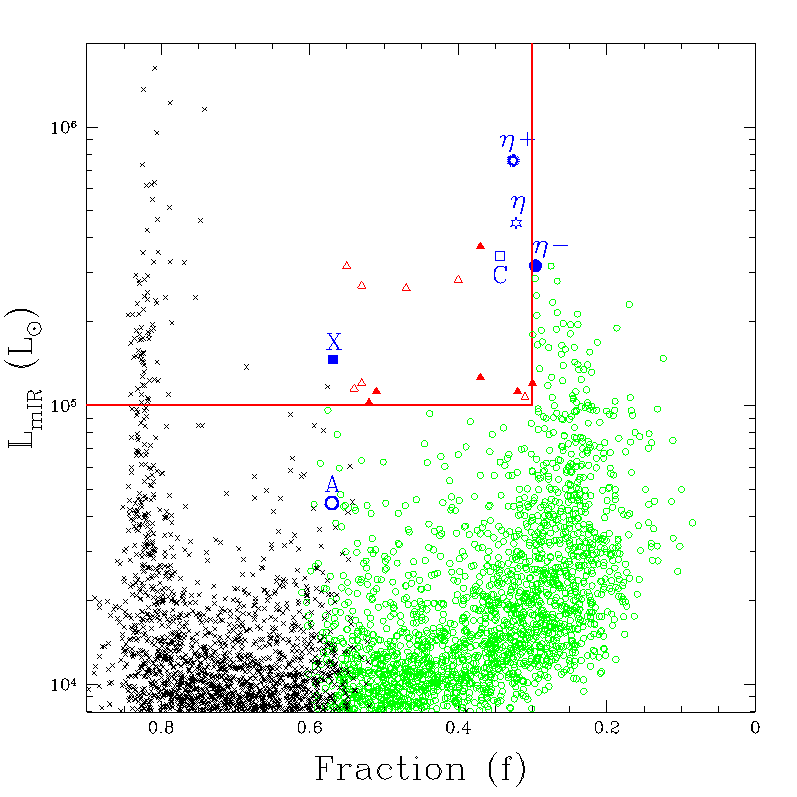
Fig.
3.— Integrated mid-IR luminosity L_mIR as a function of the fraction f
of L_mIR that is emitted between 3.6 and 5.8 μm for bright sources in
M81. The box shows the candidate selection region (L_mIR>10^5 L_⊙
and f>0.3). The red triangles show the sources that also satisfy the
third selection criteria that the mid-IR SED slope is either flat or
rising (a>0). Of these, the open red triangles correspond to
candidates that are known to be non-stellar in nature, and the solid
red triangles represent the surviving candidates. The green open
circles show sources with a<0 and the black cross marks represent
all the other sources. The narrow clump of points at f≃0.8 correspond
to normal stars with steeply falling (negative slope) mid-IR SEDs,
while the wider clump of points at f≃0.25 correspond to sources
dominated by 8 μm PAH emission. The labeled blue points are same as in
Figure 2.
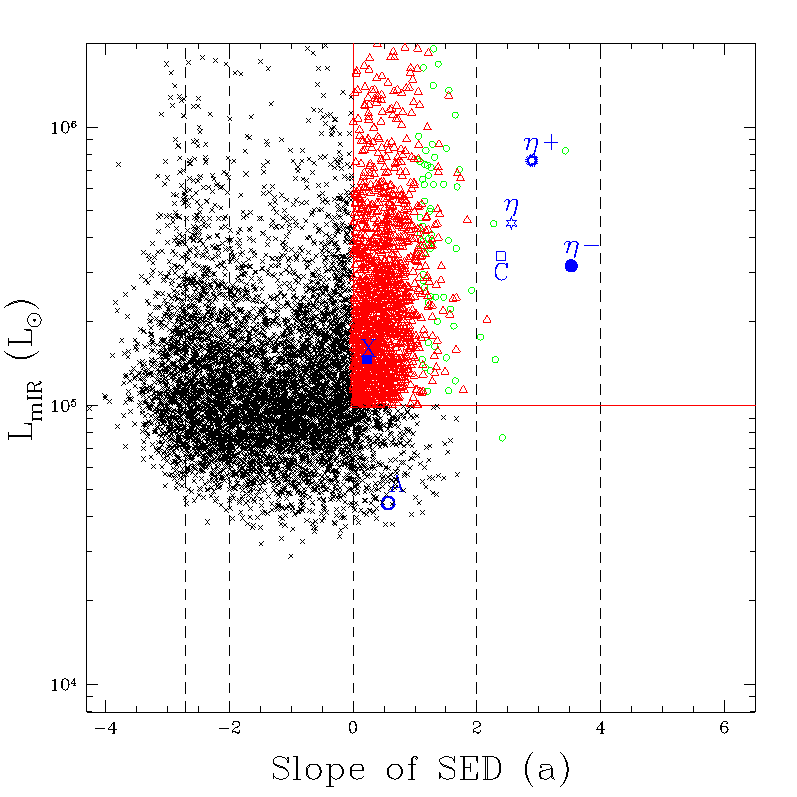
Fig.
4.— Extragalactic contamination for M81. Here we show all sources
from a 6 sq-deg region of the SDWFS survey transformed to the distance
of M81. The symbols, lines, and axis-limits are the same as in Figure
2. In this SDWFS region, 449 (~75/sq-deg) sources pass our selection
criteria, indicating that we should expect ~13 background sources
meeting our selection criteria given our 0.17 sq-deg survey region
around M81. Note that very few of the contaminating background sources
have properties comparable to η Car.

Table
3 — We estimate the expected number of extragalactic contamination for
each galaxy using the SDWFS survey (Ashby et al. 2009) where the nature
of the sources, particularly AGNs, is also well understood from the
AGES redshift survey (Kochanek et al. 2012b). We transform the apparent
magnitudes of all sources in a 6 sq-deg region of SDWFS to luminosity
using each target galaxy's distance modulus, determine how many of them
would meet our selection criteria, and correct that count for our
survey area around each galaxy. This table reports the expected surface
density of extragalactic contaminants and the number expected given the
survey area around each galaxy. We expect a total of ~41 extragalactic
sources to pass our selection criteria across the targeted galaxies, as
compared to 46 initial candidates. Figure 4, which has the same format
as Figure 2, illustrates this for M81's distance. We can already
identify 11 of the 46 initial candidates as extragalactic.
Statistically, this means that only 6+-6 are likely associated with the
galaxies. The
expected numbers of contaminating sources are generally consistent with
the observed numbers with the exception of NGC247, which we
investigated but appears to surely be a statistical fluke. The angular
distribution of the candidates relative to the galaxies is also
strongly suggestive of a dominant contribution for background sources.
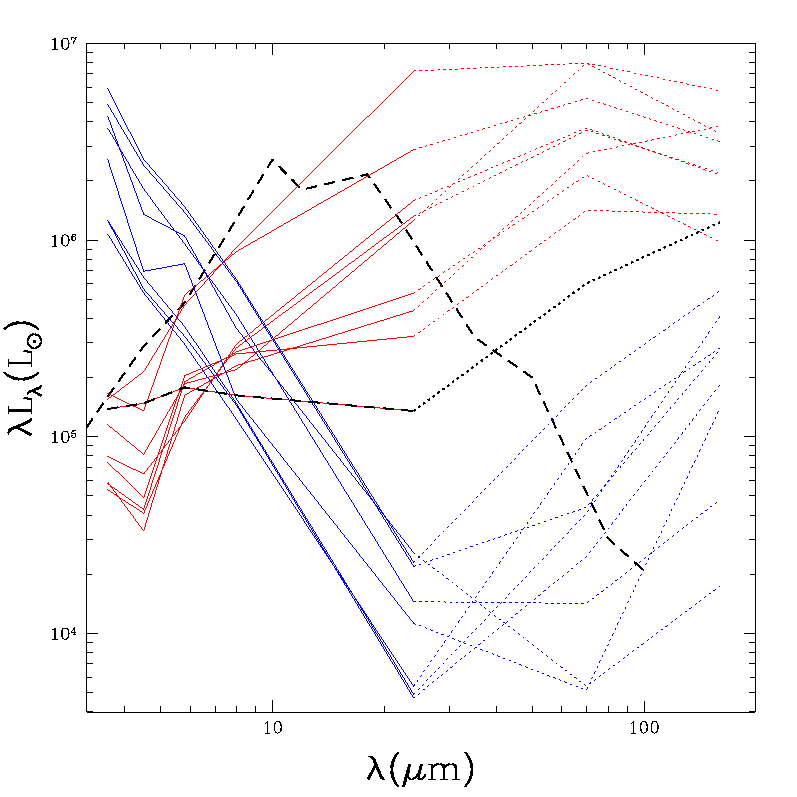
Fig.
5.— Mid and far-IR SEDs of the candidates in M33 (red lines) compared
to the SEDs of normal stars with L_mIR>10^5.5 L_⊙ , which steeply
falling SEDs (mid-IR slope a<-1, top left box of the Figure 2). The
dotted portions of the SEDs correspond to the MIPS 70 and 160 μm flux
upper limits. The SED of Object X is highlighted (red-black lighter
dashed line) and η Car (black heavier dashed line) is shown for
comparison.

Fig.
6. — The SEDs of η Car (``η'', black triangles, Humphreys &
Davidson 1994), the Carina nebula excluding η Car itself (``η-'', blue
squares, \citealpref:Smith_2007a, and the entire dusty complex
containing η Car and other massive stars including η Car (``η+'', red
circles). The first two SEDs are spline interpolated and summed to
produce the third. The SED of the compact cluster M 33-8 (``C'', green
dashed line, HST image in Figure 10) is shown for comparison. In
Figures 2, 3, and 4 we label these η, η-, η+, and ``C'' respectively.
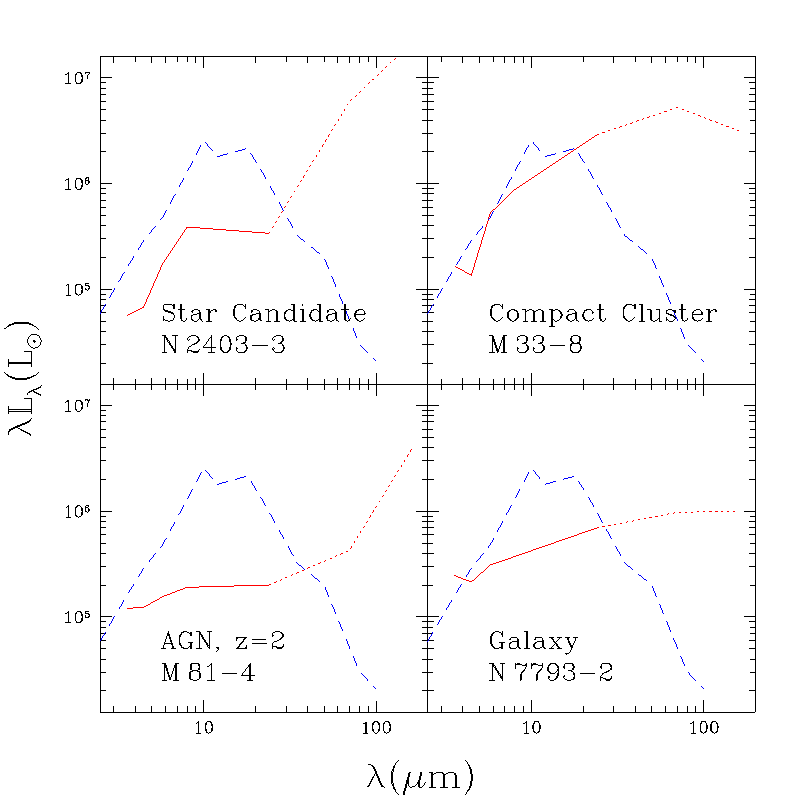
Fig.
7. — SEDs of four different classes of objects that met our selection
criteria: a candidate dusty star in NGC2403, a star-cluster in M33, a
QSO behind M81, and a galaxy behind NGC7793. Figure 10 shows IRAC and
HST images of the compact cluster and the galaxy.

Table
4 — Of the 11 rejected candidates, six are AGNs or galaxies with a
redshift measurement. Four have been photometrically classified as
galaxies by the SDSS survey (Abazajian et al. 2009) and visual
inspections of the SDSS images find diffuse extended sources consistent
with this classification. One of these sources is also 0.4′′ away from
a radio and X-ray source and is likely a low redshift AGN. One
candidate is a well-resolved galaxy in HST images. The SEDs of the
rejected candidates are shown in Figure 8 and their luminosities, SED
slope, and f are listed in this table.

Fig.
8. — SEDs of sources that met our selection criteria but were rejected
due to association with non-stellar sources. The dotted portions of the
SEDs correspond to the MIPS 70 and 160 μm flux upper limits. The SED
of η Car (dashed blue line) is shown for comparison.

Table
5 — The mid-IR luminosities, slopes, and the fractions f of the 35
remaining candidates, including Object X, are presented in this table.
Although we do not currently have an explanation, 5 of the candidates
in M33 (M 33-3 through M33-7) are within ≲ 2.0′′ of radio-selected
supernova remnants (Gordon et al. 1999). It is apparent from the SEDs
of the candidates (Figure 9) that few have mid-IR luminosities
comparable to η Car.
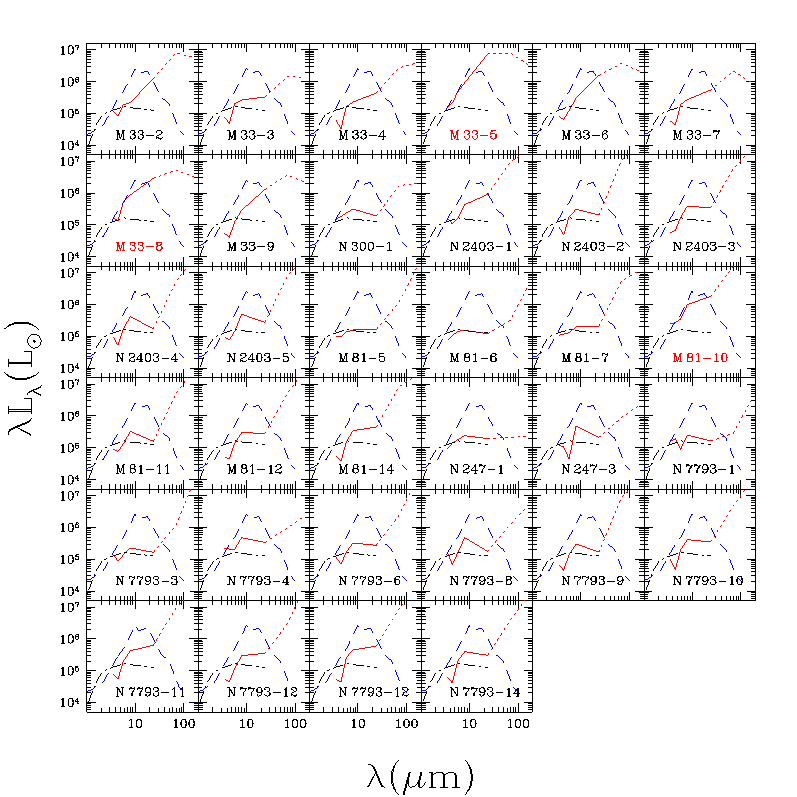
Fig.
9. — SEDs of sources that met our selection criteria and were rejected
due to association with non-stellar sources. The dotted portions of the
SEDs correspond to the MIPS 70 and 160 μm flux upper limits. The SEDs
of η Car (dashed blue line) and Object X (dot-dashed black line) are
shown for comparison. The SEDs of many sources, such as N2403-2, N247-3
and N7793-10, appear so dissimilar from the SEDs of η Car and Object X
that they seem unlikely to be stellar sources. The MIPS band luminosity
limits are also useful here. For example, the relatively low MIPS 70
and 160 μm luminosity limits indicate that N247-1 must have a very at
or falling SED at these redder wavelengths and is probably an AGN,
which is also suggested by its distance from the galaxy. On the other
hand, the SEDs of M33-5, M33-8 and M81-10 are similar to η Car while
N300-1, M81-5, M81-6 and M81-7 are similar to ObjectX (M 33-1). HST
images show that M33-5, M33-8, and M81-10 are compact star clusters
(Figure 10, top three panels). M81-5 is 0.56′′ from a variable X-ray
source with maximum luminosity of 2 x 10^38 ergs/s, which is consistent
with the source being an X-ray binary (Remillard & McClintock
2006). M81-7 has been classified as a galaxy by the SDSS survey but
with a photometric redshift z = 0:00049 comparable to that of M81
(Abazajian et al. 2009). HST images show a region of enhanced star
formation consisting of at least two components. Ancillary data also
shows that N7793-3 is a High-Mass X-ray Binary (Mineo et al. 2012) with
maximum X-ray luminosity of 3.9 x 10^37 ergs/s (Liu 2011). Although we
do not currently have an explanation, 5 of the candidates in M33 (M
33-3 through M33-7) are within ≲ 2.0′′ of radio-selected supernova
remnants (Gordon et al. 1999).
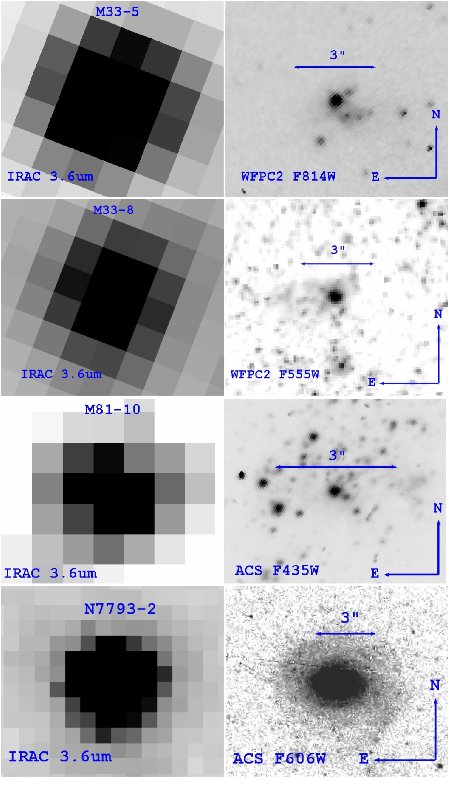
Fig.
10.— IRAC and HST images of the compact stellar clusters M33-5, M33-8,
and M81-10, and the background galaxy N7793-2. The clusters are
resolved in the HST images with FWHM of ~0.87′′≃4.1pc (M33-5),
~0.77′′≃3.6pc (M33-8) and 0.34′′≃6.1pc (M81-10). They are very luminous
(few x 10^7 L_⊙) and their SED shapes are very similar to η Car (Figure
9).

Table
6 — 9 of the candidates from Table 5 also have 2MASS photometry and
their near-IR magnitudes are presented in this table along with
the UBVRI magnitudes of the closest optical counterparts for the three
candidates in M33 for which there is a publicly available catalog
(Massey et al. 2007).
Acknowledgements:
We thank the referee, Roberta Humphreys, for valuable suggestions,
John Beacom for numerous productive disucssions, and Jose Prieto,Todd
Thompson, Shunsaku Horiuchi and Joe Antognini for helpful
comments. We extend our gratitude to the SINGS Legacy Survey and
LVL
Survey for making their data publicly available. This research has made
use of NED, which is operated by the JPL and Caltech, under contract
with NASA and the HEASARC Online Service, provided by NASA's GSFC. RK
and KZS are supported in part by NSF grant AST-1108687. KZS and CSK are
supported in part by NSF grant AST-0908816.
















